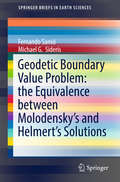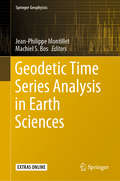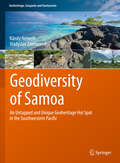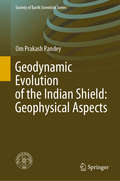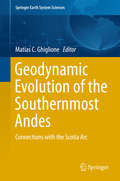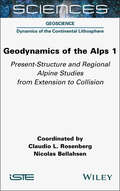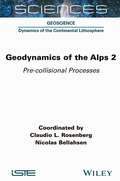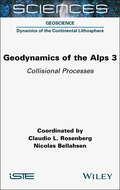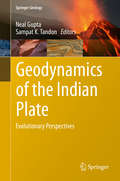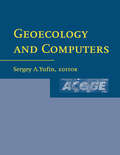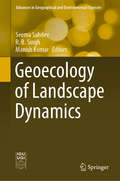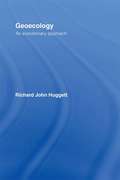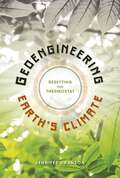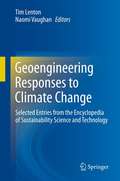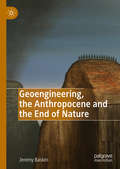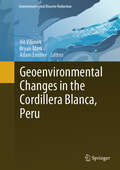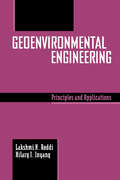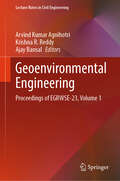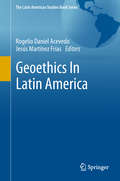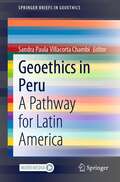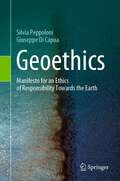- Table View
- List View
Geodetic Boundary Value Problem: the Equivalence between Molodensky’s and Helmert’s Solutions
by Fernando Sansò Michael G. SiderisThis book offers a new approach to interpreting the geodetic boundary value problem, successfully obtaining the solutions of the Molodensky and Stokes boundary value problems (BVPs) with the help of downward continuation (DC) based methods. Although DC is known to be an improperly posed operation, classical methods seem to provide numerically sensible results, and therefore it can be concluded that such classical methods must in fact be manifestations of different, mathematically sound approaches. Here, the authors first prove the equivalence of Molodensky's and Stoke's approaches with Helmert's reduction in terms of both BVP formulation and BVP solutions by means of the DC method. They then go on to show that this is not merely a downward continuation operation, and provide more rigorous interpretations of the DC approach as a change of boundary approach and as a pseudo BVP solution approach.
Geodetic Time Series Analysis in Earth Sciences (Springer Geophysics)
by Jean-Philippe Montillet Machiel S. BosThis book provides an essential appraisal of the recent advances in technologies, mathematical models and computational software used by those working with geodetic data. It explains the latest methods in processing and analyzing geodetic time series data from various space missions (i.e. GNSS, GRACE) and other technologies (i.e. tide gauges), using the most recent mathematical models. The book provides practical examples of how to apply these models to estimate seal level rise as well as rapid and evolving land motion changes due to gravity (ice sheet loss) and earthquakes respectively. It also provides a necessary overview of geodetic software and where to obtain them.
Geodiversity of Samoa: An Untapped and Unique Geoheritage Hot Spot in the Southwestern Pacific (Geoheritage, Geoparks and Geotourism)
by Károly Németh Vladyslav ZakharovskyiThis book represents a pioneering effort, offering a comprehensive summary of the Geoheritage of the Southwestern Pacific (SW Pacific). Despite its globally significant Geoheritage , the region has not yet been addressed in its entirety within a cohesive geocultural context, either in book form or through similar media. The SW Pacific is still emerging as a focal point of Geoheritage research, and exploration of the vast geodiversity of this region has only recently begun. While some initial scientific reports exist for specific areas within the SW Pacific, there has been no comprehensive summary covering the entire region. Although the region is primarily renowned for its picturesque beaches and tranquil coastal landscapes, its rich Geocultural aspects remain largely underutilized and understudied. It aims to fill this gap by providing a holistic exploration of the geodiversity and geoheritage of the Samoa islands. By offering an evidence-based and scientifically valid overview of the islands' geoheritage and geodiversity, the book seeks to serve as a foundational resource for future developments in the tourism sector and to define research directions and methodologies for expanding our understanding of volcanic oceanic islands' geoheritage. It will focus on geodiversity and geoheritage within the context of volcanic oceanic islands, which are unique in terms of their geological formations (such as volcanoes and lava fields) and their limited spatial extent within the vast Pacific Ocean basin. This book will also highlight the special coastal regions of volcanic oceanic islands, which often feature fringed reefs and broad shallow marine environments housing unique and fragile ecosystems sensitive to global and planetary changes. By estimating geodiversity, the book will provide insight into how volcanic islands' geoheritage intersects with biodiversity. Geodiversity will be explored as the backdrop for the evolution of tropical marine and mountainous biodiversity in spatially limited areas under tropical conditions. Moreover, this book aims to be a pioneering contribution, offering a methodological manual for exploring other islands from a geodiversity perspective. Currently, there is no similar publication on the market, making this book one of the first of its kind. The authors have conducted extensive research in Samoa, resulting in numerous high-level scientific publications and a wealth of information to be included in this book.
Geodynamic Evolution of the Indian Shield: Geophysical Aspects (Society of Earth Scientists Series)
by Om Prakash PandeyThis book addresses time-bound geotectonic evolution of the various geological terrains of the Indian continent, on the basis of integrated geophysical studies, like seismic, seismological, gravity, magnetic, magnetotelluric and heat flow, carried out over the past five decades. Further, it discusses elastic and petrophysical properties of the Earth’s crust relevant to geological investigations. The book also shares latest findings on the geodynamic development of the Indian shield and nearby continental margins, including Arabian Sea.
Geodynamic Evolution of the Southernmost Andes
by Matías C. GhiglioneThis book focuses on the strong relation between the tectonic evolution of the Southernmost Andes and their closest southern neighbors, the Scotia Sea and Antarctica. Some episodes are related to processes of global significance such as the opening of the Drake Passage, which is somehow linked to Late Cenozoic cooling. Many of the topics covered in the book are subjects of heated debates; as such, not only the latest data and approaches are presented, but different points of view as well. The chapters examine the interrelation between main geodynamic processes and plate tectonics from a multidisciplinary perspective. This Paleozoic-Cenozoic geodynamic evolution of the Southernmost Andes involved interrelated metamorphic, magmatic, sedimentary, and deformational processes directed by plate tectonics. The main topics cover the evolution of the Rocas Verdes basin and the Cordillera Darwin high-grade metamorphic complex, growth of the Patagonian Batholith, development of the Patagonian Orocline, the opening of the Drake Passage during growth of the Scotia Sea, evolution of the Austral-Magallanes foreland basin and its related fold and thrust belt.
Geodynamics
by Donald L. Turcotte Gerald SchubertFirst published in 1982, Don Turcotte and Jerry Schubert's Geodynamics became a classic textbook for several generations of students of geophysics and geology. In this second edition, the authors bring this text completely up-to-date. Important additions include a chapter on chemical geodynamics, an updated coverage of comparative planetology based on recent planetary missions, and a variety of other new topics. Geodynamics provides the fundamentals necessary for an understanding of the workings of the solid earth, describing the mechanics of earthquakes, volcanic eruptions, and mountain building in the context of the role of mantle convection and plate tectonics. Observations such as the earth's gravity field, surface heat flow, distribution of earthquakes, surface stresses and strains, and distribution of elements are discussed. This new edition will once again prove to be a classic textbook for intermediate to advanced undergraduates and graduate students in geology, geophysics, and earth science.
Geodynamics of the Alps 1: Present-Structure and Regional Alpine Studies from Extension to Collision
by Claudio L. Rosenberg Nicolas BellahsenGeodynamics of the Alps consists of three volumes. This first volume describes the recent and present-day structure and tectonic setting of the Alpine chain, from the lithospheric mantle to brittle crust and surface topography. It also provides a historical overview of Alpine research, with two chapters covering specific Alpine regions (Corsica and the Eastern Alps) through all phases of Alpine history. The aim of this book is to create a space for experts on Alpine research to present the state of the art of specific subjects and provide their own interpretations.
Geodynamics of the Alps 2: Pre-collisional Processes
by Claudio L. Rosenberg Nicolas BellahsenGeodynamics of the Alps consists of three volumes. This second volume presents the pre-collisional history of the Alps. It discusses the Variscan orogeny in the Alpine realm, the inferred paleo-geography, the structure and processes affecting continental margins and the mantle structure in the pre-orogenic Alpine realm. It concludes by describing oceanic and continental subduction processes. The aim of this book is to create a space for experts on Alpine research to present the state of the art of specific subjects and provide their own interpretations.
Geodynamics of the Alps 3: Collisional Processes
by Claudio L. Rosenberg Nicolas BellahsenGeodynamics of the Alps consists of three volumes. This third volume is entirely dedicated to Alpine collision. It describes and interprets elements of the Alpine chain, including Alpine magmatism, the formation of external massifs, the foreland basin, the exhumation of the internal part of the chain and the northern deformation front of the Alps. The aim of this book is to create a space for experts on Alpine research to present the state of the art of specific subjects and provide their own interpretations.
Geodynamics of the Indian Plate: Evolutionary Perspectives (Springer Geology)
by Neal Gupta Sampat K. TandonThis book provides insights on new geological, tectonic, and climatic developments in India through a time progression from the Archean to the Anthropocene that are captured via authoritative entries from experts in earth sciences. This volume aims to bring graduate students and researchers up to date on the geodynamic evolution of the Indian Plate; concepts that have so far resulted in a rather uneven treatment of the subject at different institutions.The book is divided into 4 sections and includes perspectives such as the formation and evolution of the Indian crust in comparison to its neighbors such as Antarctica, Africa and Australia; the evolution of Precambrian cratons and sedimentary basins of India; and a summary account of early life reported in the Indian stratigraphic record. Readers will also discover the key recent research into the neotectonics, tectonic geomorphology, and paleoseismology of the Himalayan Front. Researchers and students in geology, earth sciences, sedimentology, paleobiology and geography will find this book appealing.
Geoecology and Computers
by Sergey A. YufinThis volume presents technical papers devoted to development and practical use of computer methods in geotechnical and geoenviromental engineering. It covers issues on space use and construction, soil and rock mechanics, and mining applications amongst other topics.
Geoecology of Landscape Dynamics (Advances in Geographical and Environmental Sciences)
by R. B. Singh Manish Kumar Seema SahdevThis book provides an overview of the ecological indicators of landscape dynamics in the context of geographical landscape integration. Landscape dynamics depicts every change that occurs in the physical, biological, and cognitive assets of a landscape. To understand and interpret the complex physical, biological, and cognitive phenomena of landscapes, it is necessary to operate conceptually and practically on a broad range of spatial and temporal scales. Rapid land use changes have become a concern to environmentalists and planners because of their impacts on the natural ecosystem, which further determines socioeconomic dynamics. In this regard, the book discusses case studies that share new insights into how landscape patterns and processes impact small creatures, and how small creatures in turn influence landscape structure and composition. In turn, the relevant aspects of land use and land cover dynamics are covered, and the multi-faceted relationship between the substrata and ecological community is highlighted. The book is unique in its focus on the application of spatial informatics such as automatic building extraction from high-resolution imagery; a soil resource inventory for meeting the challenges of land degradation; hydrological modeling; the temporal variation analysis of glacier area and the identification and mapping of glacial lakes; morphometric analysis of river basins; and the monitoring and modeling of urban sprawl, among other features.
Geoecology: An Evolutionary Approach
by Richard HuggettAnimals, plants and soils interact with one another, with the terrestrial spheres, and with the rest of the Cosmos. On land, this rich interaction creates landscape systems or geoecosystems. Geoecology investigates the structure and function of geoecosystems, their components and their environment. The author develops a simple dynamic systems model, the `brash' equation, to form the conceptual framework for the book suggesting an `ecological' and `evolutionary' approach. Exploring internal of `ecological' interactions between geoecosystems and their near-surface environments - the atmosphere, hydrosphere, toposhere, and lithosphere - and external influences, both geological and cosmic, Geoecology presents geoecosystems as dynamic entities constantly responding to changes within themselves and their surroundings. An `evolutionary' view emerges of geoecological systems, and the animals, plants, and soils comprising them, providing a new way of thinking for the whole environmental complex and the rich web of interdependencies contained therein.
Geoeconomics of the Sustainable Development Goals (Frontiers of Geoeconomics, Geopolitics and Sustainability)
by Bernadette Andreosso-O’Callaghan Lucía Morales Daniel RajmilIn 2015, the United Nations introduced its very ambitious 2030 Agenda, known as the Sustainable Developmental Goals or SDGs. The SDGs provide a comprehensive list of goals and targets to address social, economic and environmental issues. In this book, different areas of expertise are brought together, examining the main challenges associated with the effects of “climate change” and the broader scope of the SDGs through the lenses of the geo-economics and geopolitics of sustainability. The book sheds light on the growing connections between the economic and financial fields and their impact on defining the international order and its economy. It examines the importance of trade and economic integration in promoting sustainable development and achieving the SDGs.The role of supranational organisations like the United Nations, the World Trade Organisation and the IMF in supporting the SDGs within the context of the world’s most advanced economies and those less developed; the influence of economic diplomacy and geopolitical rivalries on progress towards the SDGs; the changing global balance of power and the significance of technology and innovation; as well as the role of emerging and less developed economies in enabling sustainable development. The book offers insights into practical issues linked to theory and applied frameworks, underscoring the significant challenges associated with sustainable development, the global economic and political reality, and how political tensions affect the global economy.The book supports students through the established disciplines of economics, finance, political science, and law and provides academics with new research and theory-building tools.
Geoengineering Earth's Climate: Resetting the Thermostat
by Jennifer SwansonMost scientists agree that Earth is warming rapidly. Glaciers are melting and rising seawaters are submerging islands and coastal cities. In the coming decades, millions will likely have to escape extreme weather caused by climate change. Some scientists say we need to act faster and with radical new technologies—now—to save our planet. They propose geoengineering, or "engineering Earth," to reset our global thermostat. Ideas include thickening clouds with chemicals to reduce the amount of sunlight and pulling carbon dioxide from the air with machines. However, critics say that geoengineering could backfire and create even worse weather. Is geoengineering too risky? Or is it our best hope of survival?
Geoengineering Responses to Climate Change
by Naomi Vaughan Tim LentonFailure by the international community to make substantive progress in reducing CO2 emissions, coupled with recent evidence of accelerating climate change, has brought increasing urgency to the search for additional remediation approaches. This book presents a selection of state-of-the-art geoengineering methods for deliberately reducing the effects of anthropogenic climate change, either by actively removing greenhouse gases from the atmosphere or by decreasing the amount of sunlight absorbed at the Earth's surface. These methods contrast with more conventional mitigation approaches which focus on reducing emissions of greenhouse gases, especially carbon dioxide. Geoengineering technologies could become a key tool to be used in conjunction with emissions reduction to limit the magnitude of climate change. Featuring authoritative, peer-reviewed entries from the Encyclopedia of Sustainability Science and Technology, this book presents a wide range of climate change remediation technologies.
Geoengineering, the Anthropocene and the End of Nature
by Jeremy BaskinThis book takes a critical look at solar geoengineering as an acceptable means for addressing climate change. Baskin explores the assumptions and imaginaries which animate ‘engineering the climate’ and discusses why this climate solution is so controversial. The book explains geoengineering’s past, its revival in the mid-2000s, and its future prospects including its shadow presence in the Paris climate accord. The main focus however is on dissecting solar geoengineering today – its rationales, underpinning knowledge, relationship to power, and the stance towards nature which accompanies it. Baskin explores three competing imaginaries associated with geoengineering: an Imperial imaginary, an oppositional Un-Natural imaginary, and a conspiratorial Chemtrail imaginary. He seeks to explain why solar geoengineering has struggled to gain approval and why resistance to it persists, despite the support of several powerful actors. He provocatively suggests that reconceptualising our present as the Anthropocene might unwittingly facilitate the normalisation of geoengineering by providing a sustaining socio-technical imaginary. This book is essential reading for those interested in climate policy, political ecology, and science & technology studies.
Geoenvironment, An Introduction
by U. AswathanaraynaThe focus of this book is on the management of the geoenvironment. It seeks to explain how, through an understanding of the environmental processes that take place in rocks, soils, waters, sediments, air and so on, the resources contained in them could be managed sustainably. Topics covered in the book include: Ecologically-sustainable industrial development; dynamics of the geoenvironment; the impact of mining on rocks, soils, water and biota; the natural radiation environment; the use of geotechnology to mitigate the consequences of natural disasters and the disposal of various kinds of waste, particulary hazardous waste. The models proposed by the World Bank on how to make environemntal amelioration economcially viable are also looked at.
Geoenvironmental Changes in the Cordillera Blanca, Peru (Geoenvironmental Disaster Reduction)
by Vít Vilímek Bryan Mark Adam EmmerThis book focuses on Peru’s highest and most glacierized mountain range – the Cordillera Blanca. This mountain range experienced numerous disasters in the past (e.g. lake Palcacocha outburst in 1941, earthquake-induced ice and rock avalanche from Mt. Huascarán in 1970) and has attracted the attention of researchers from around the world. The 15 chapters of the book span from broadly thematic topics of geology, geomorphology, climate, hydrology and hydrogeology, lakes, glaciation, and environmental settings to more specific topics and emergent themes of relevance for the Cordillera Blanca, including studies of various types of natural hazards (landslides, GLOFs). While most of the chapters focus on biophysical processes of the natural environment, several chapters explore the complex interactions between humans and environmental factors, providing insights and perspectives from social science and the humanities. This book offers an unprecedentedly comprehensive overview of the state-of-the-art knowledge about the geo-environmental changes in the Cordillera Blanca.
Geoenvironmental Engineering: Principles and Applications
by Hilary I. Inyang Lakshmi ReddiApplies science and engineering principles to the analysis, design, and implementation of technical schemes to characterize, treat, modify, and reuse/store waste and contaminated media. Includes site remediation.
Geoenvironmental Engineering: Proceedings of EGRWSE-23, Volume 1 (Lecture Notes in Civil Engineering #508)
by Krishna R. Reddy Arvind Kumar Agnihotri Ajay BansalThis book contains peer-reviewed and selected papers presented during the International Conference on Environmental Geotechnology, Recycled Waste Materials and Sustainable Engineering (EGRWSE) 2023, held at NIT Jalandhar. It discusses the recent innovations, trends, concerns, practical challenges encountered, and the solutions adopted in waste management and engineering, geotechnical and geoenvironmental engineering, infrastructure engineering and sustainable engineering. This book can serve as a useful resource for researchers, educators, policymakers, and professionals working in the field of civil engineering, chemical engineering, environmental sciences, and public policy.
Geoenvironmental and Geotechnical Issues of Coal Mine Overburden and Mine Tailings (Springer Transactions in Civil and Environmental Engineering)
by Krishna R. Reddy Sarat Kumar Das Lohitkumar Nainegali Surabhi JainThis contributed book edited by leading global experts focuses on the geoenvironmental and geotechnical issues of coal mine overburden and mine tailings and its unengineered dumping. It aims to provide knowledge-based information for diverse readers to assess, monitor, and manage coal mine overburden and mine tailings in various engineering applications while highlighting efficient solutions to reutilize the waste and conserve natural resources leading to sustainable development. The content also assesses mine backfilling, techniques to stabilize mine tailing storage facilities, mineral carbonation of mine tailings, landfill liners and barrier systems, reclamation of coal mine overburden, and geochemical, microbial, and environmental sustainability assessment, among others. This book is a useful resource for those in academia and industry.
Geoethics In Latin America (The Latin American Studies Book Series)
by Rogelio Daniel Acevedo Jesús Martínez FríasThis book studies geoethics in Latin America and offers comprehensive research on geoethics and geoeducation. Its respective chapters explore geoethics in relation to UNESCO geoparks, mining activities in Latin America, natural hazards and risk management. Geoethics is a key discipline in the field of Earth and Planetary Sciences, and not only includes scientific, technological, methodological and social-cultural aspects, but also addresses the need to consider appropriate protocols, scientific integrity issues and a code of good practice when studying the abiotic world.The position of Latin America’s recently created geoethics associations is based on protection of the environment, together with a reassurance that the balance of nature and the rights of human beings to enjoy it will be preserved.
Geoethics in Peru: A Pathway for Latin America (SpringerBriefs in Geoethics)
by Sandra Paula Villacorta ChambiThe book discusses geoscience issues in Peru from a geoethical perspective, based on the leading experience of the Peruvian section of the International Association for Promoting Geoethics, in its seven years of activity.The introduction will present past and current activities to promote geoethics in Peru, such as the organization of the MinerLima exhibition (that has teaching purposes); the implementation of geoethics in georisk communication with vulnerable populations, as well as the promotion of adequate knowledge about national geological heritage. The other chapters will describe the main geoethical issues in Peru, related to georisk management and communication, mining, paleontology and geoheritage, geoducation. Some proposals for actions that should be taken to improve societal awareness and to make progress in problem-solving from a geoethical perspective will be discussed for each issue.In the final chapter Peruvian geoescience implications and new roles for geoscientists will be discussed, providing clues to their participation in the management of socio-environmental problems that affect Latin American region. It will be also underlined how geoethics represents a new theoretical and practical approach that may contribute in the current process to modernize geoscience education in Latin America.In this sense, this publication provides a solid base to apply the theoretical framework of Geoethics in Peru that may be suggested as an example to promote geoethics in other Latin American countries. As a result, the need to inform and prepare the population of growing countries such as Peru to face the problems of the modern world is evident.In order to attract more readers in Latin America, each chapter will be provided with a summary in Spanish.
Geoethics: Manifesto for an Ethics of Responsibility Towards the Earth
by Silvia Peppoloni Giuseppe Di CapuaThis book outlines the current development of geoethical thinking, proposing to the general public reflections and categories useful for understanding the ethical, cultural, and societal dimensions of anthropogenic global changes. Geoethics identifies and orients responsible behaviors and actions in the management of natural processes, redefining the human interaction with the Earth system based on a critical, scientifically grounded, and pragmatic approach. Solid scientific knowledge and a philosophical reference framework are crucial to face the current ecological disruption. The scientific perspective must be structured to help different human contexts while respecting social and cultural diversity. It is impossible to respond to global problems with disconnected local actions, which cannot be proposed as standard and effective operational models. Geoethics tries to overcome this fragmentation, presenting Earth sciences as the foundation of responsible human action toward the planet. Geoethics is conceived as a rational and multidisciplinary language that can bind and concretely support the international community, engaged in resolving global environmental imbalances and complex challenges, which have no national, cultural, or religious boundaries that require shared governance. Geoethics is proposed as a new reading key to rethinking the Earth as a system of complex relationships, in which the human being is an integral part of natural interactions.
